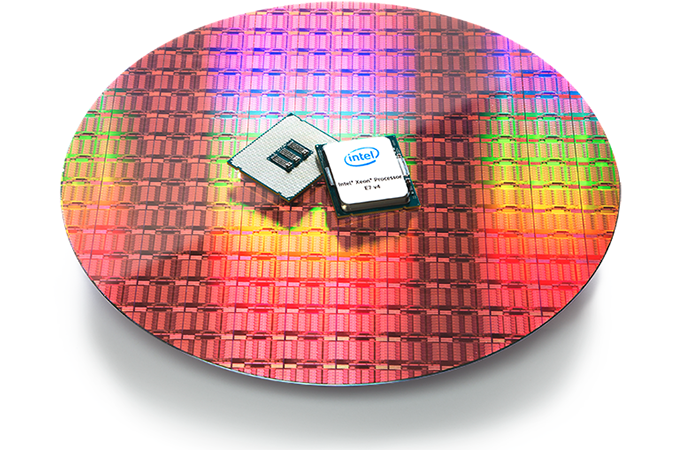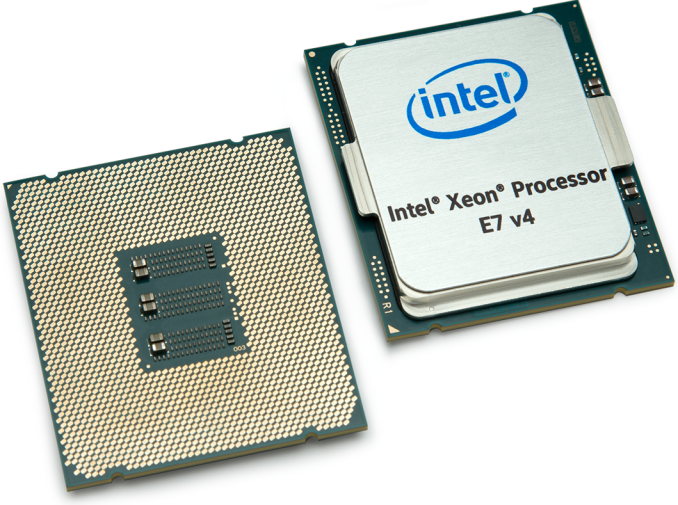Intel Announces the Xeon E7-8894 v4 CPU: 24 Cores at 2.4 GHz for $8898
by Anton Shilov on February 13, 2017 9:00 AM EST- Posted in
- CPUs
- Intel
- Xeon
- Servers
- Broadwell-EX
- E7-8894 v4

In the past week, Intel has launched a new halo CPU - its highest-performing multi-core CPU for multi-socket mission-critical servers, the Xeon E7-8894 v4. The new processor is based on the Broadwell-EX die and has approximately a 200 MHz higher base frequency than its direct predecessor, released in Q2 2016. Intel said that the new CPU has set a number of records in various benchmarks. Intel’s customers interested in the chip will also have to pay a record price too.
The flagship Intel Xeon E7-8894 v4 processor features the Broadwell-EX XCC (extreme core-count) die and has 24 cores with Hyper-Threading technology, 60 MB of L3 cache, 165 W TDP, a default frequency of 2.4 GHz and a turbo frequency of up to 3.4 GHz. Like other Broadwell-EX XCC CPUs, the new chip has quad-channel DDR3/DDR4 memory controller support and can manage up to ~3 TB of DRAM per socket (when used in conjunction with four Jordan Creek 2 scalable memory buffers). The CPUs are also equipped with 32 PCIe 3.0 lanes and three 9.6 GT/s QPI links for multi-socket environments.
| Intel E7-8800 v4 Xeon Family | ||||||||
| E7-8867 v4 | E7-8870 v4 | E7-8880 v4 | E7-8890 v4 | E7-8894 v4 |
E7-8891 v4 | E7-8893 v4 | ||
| TDP | 165 W | 140 W | 150 W | 165 W | 165 W | 140 W | ||
| Cores | 18 / 36 | 20 / 40 | 22 / 44 | 24 / 48 | 10 / 20 | 4 / 8 | ||
| Base Freq | 2400 | 2100 | 2200 | 2200 | 2400 | 2800 | 3200 | |
| Turbo | 3300 | 3000 | 3300 | 3400 | 3500 | 3500 | ||
| L3 Cache | 45 MB | 50 MB | 55 MB | 60 MB | 60 MB | 60 MB | ||
| QPI (GT/s) | 3 × 9.6 | 3 x 9.6 | 3 x 9.6 | |||||
| DRAM | DDR4-1866 DDR3-1600 |
DDR4-1866 DDR3-1600 |
||||||
| PCIe | PCIe 3.0 x32 | 3.0 x32 | 3.0 x32 | |||||
| Price | $4672 | $4762 | $5895 | $7174 | $8898 | $6841 | $6841 | |
Intel’s multi-core Xeon E7 processors are designed for various heavy-duty servers with four, eight or more sockets (to support more than eight sockets special third-party node controllers are required). Such mission-critical machines typically to be available 24/7/365 and this is why the Xeon E7 v4 and the Broadwell-EX range has a host of various RAS (reliability, availability, serviceability) features. The Xeon E7-8894 v4 CPU has exactly the same set of capabilities as its direct predecessor, the Xeon E7-8890 v4 released last year.
Intel claims that due to increased default frequency (and obviously because of the core count in general), the Xeon E7-8894 v4 sets a number of performance records in various general, server, HPC, big data analytics, business processing, database and other benchmarks, such as SPECint_base2006, SPECompG_2012, and so on.
The Intel Xeon E7-8894 v4 processor carries a tray price of $8898, which is the highest price of an Intel mass-produced CPU ever. Its predecessor on the top spot in the range, the 24-core Xeon E7-8890 v4 (which runs at 2.2 GHz) is priced at $7174 and still sits at its original tray price. As always, there are customers willing to pay such sums of money for server CPUs that deliver certain levels of performance. Moreover, there are workloads that benefit from a +200MHz (9%) performance increase so significantly (from a financial point of view to the owners of the machines) that it justifies paying extra 24% (or $1724) for a 200 MHz frequency increase (provided that this is the only advantage that this CPU has over the E7-8890 v4).
| Intel Xeon E-Series Families (February 2017)* | |||||
| E3-1200 v5 | E3-1500 v5 | E5-1600 v4 E5-2600 v4 E5-4600 v4 |
E7-4800 v4 | E7-8800 v4 | |
| Core Family | Skylake | Skylake | Broadwell | Broadwell | Broadwell |
| Core Count | 2 to 4 | 2 to 4 | 4 to 22 | 8 to 16 | 4 to 24 |
| Integrated Graphics | Few, HD 520 | Yes, Iris Pro | No | No | No |
| DRAM Channels | 2 | 2 | 4 | 4 | 4 |
| Max DRAM Support (per CPU) | 64 GB | 64 GB | 1536 GB | 3072 GB | 3072GB |
| DMI/QPI | DMI 3.0 | DMI 3.0 | 2600: 1xQPI 4600: 1xQPI |
3 QPI | 3 QPI |
| Multi-Socket Support | No | No | 2600: 1S/2S 4600: 1S/2S |
1S, 2S or 4S | Up to 8S |
| PCIe Lanes | 16 | 16 | 40 | 32 | 32 |
| Cost | $213 to $612 |
$396 to $1207 |
$294 to $7007 |
$1223 to $3003 |
$4061 to $8898 |
| Suited For | Entry Workstations | QuickSync, Memory Compute |
High-End Workstation | Many-Core Server | World Domination |
*Intel also has the E3-1500M v5 and E3-1500M v6 mobile parts which are left out of this table
We've asked Intel to disclose the official per-core turbo numbers for comparison to their other chips, as well as a full range of DRAM support depending on memory type and memory density. We will update this news piece as we get more information.
Related Reading:
Source: Intel











83 Comments
View All Comments
jabber - Monday, February 13, 2017 - link
Will look forward to picking one up on Ebay for £50 in a few years.bill.rookard - Monday, February 13, 2017 - link
Haha. Indeed. I don't think it will ever really hit $50.00 but if it falls to $250.00 it would be worth it to pick up.My question is pretty simple though. What about the Ryzen based server parts which you know will be hitting soon. The 32 core Naples chip - assuming that the Zen cores are indeed solid - and assuming that the pricing is similarly aggressive in their pricing - is likewise going to shake up the server market. I'd love to see how long that pricing at almost $9,000 per cpu will hold.
Black Obsidian - Monday, February 13, 2017 - link
AMD's penetration in the server market has historically been almost entirely on the low end, despite having had some mid-range and even a couple of high-end (4S) offerings.It'll be interesting to see if Ryzen changes that, but I wouldn't hold my breath. For the 4S workloads I'm familiar with, a $9K CPU--or even the $100K box as whole, once you factor in 4 such CPUs and a couple TB of RAM--is a rounding error on the licensing costs of the software running on it and the professional(s) hired to use it.
Meteor2 - Tuesday, February 14, 2017 - link
So what *are* the workloads for a 4S or a 8S server running these chips (and packing up to, what, 24 TB of RAM)? Running thousands of VMs in one box?keeepcool - Tuesday, February 14, 2017 - link
High Frequency Trading bots, google search, and lots more banking stuff, paired with buckets of FPGA's.Kevin G - Tuesday, February 14, 2017 - link
High frequency trading prefers low latency above anything else. Those systems often use lower core counts at higher clocks to shave off a bit of time. This chip doesn't fit well into that role vs. other models from Intel.nils_ - Tuesday, February 14, 2017 - link
Also, you don't really want NUMA in HFT, so there is little point in getting that many sockets.Brutalizer - Tuesday, February 14, 2017 - link
There are many types of high frequency traders. Scalpers needs ultra low latency, and they prefer a few highly clocked cores. Say an algorithm needs 20 steps before you can decide to trade or not, if you have 4GHz you finish 20 steps before another cpu that uses 2GHz. So HFT are not interested in these E7 cpus, they are too low clocked.The use case for these E7 cpus with up to 8-sockets, are large business servers such as SAP, databases, etc - such ERP business software must run on a single large machine, and can not be run on clusters such as SGI UV3000 servers. The largest scale-up business servers typically have 16 or 32-sockets. The largest scale-up clusters, typically have 10.000s of cores and 100s of TB of RAM - in effect a mini super computing cluster. The largest scale-up business server that SGI has, is a UV300H with 24-sockets, or have SGI released a new model with 32-sockets now? Anyway, business servers stop at 32-sockets. Scale out HPC clusters go to 10.000s of cores and above. But they can not run business software (because such software communicate too much between the cpus, so it can not spread out on a slow cluster)
I have checked the "world records" that Intel claim. And they are somewhat strange. For instance, Intel claims 4-socket server world record of 43.300 saps. Well, one 2-socket SPARC M7 server reaches 30.800 saps. https://blogs.oracle.com/partnertech/entry/new_sap...
And if you go to 8-sockets, SPARC M7 reaches 130.000 saps: https://blogs.oracle.com/BestPerf/entry/20160531_s...
So, Intel is able to claim the "4-socket sap world record" only because Oracle has not bothered to benchmark 4-socket SPARC M7 servers.
Likewise with the next benchmark I bothered to check, Java specjbb2015. 16-socket Integrity HP Superdome, reaches: 776,269 max-jOPS and 84,557 critical-jOPS. The number of interest is usually the critical-jOPS. But anyway, let us compare both numbers to one single SPARC M7 cpu: 120,603 max-jOPS and 60,280 critical-jOPS.
https://blogs.oracle.com/BestPerf/entry/201511_spe...
In other words, the 16-socket Intel E7 cpu server might have the 16-socket world record, but if Oracle just bothers to benchmark a 8-socket SPARC M7 server, then Oracle will easily get the world record.
I think the other "world records" are similar. Because, typically, SPARC M7 is 2-3x faster than the fastest Intel Xeon or POWER8. And if this E7 want to compete with SPARC M7, it must be 2-3x faster than the E5-2699v4 cpu. Which can not happen. So I would be very surprised if Intel manages to snatch one single world record from SPARC M7 on a socket-per-socket basis. We all know that Intels new cpus are not 200-300% faster than the previous generation, no, they are only 10% faster or so. To compete with SPARC, Intel needs 200-300% improvements.
Meteor2 - Wednesday, February 15, 2017 - link
One of these days I'll work out just what the hell SAP is...BrokenCrayons - Wednesday, February 15, 2017 - link
SAP is the goop that comes out of a tree or plant after you damage it somehow. Some people process certain types of SAP to make delicious syrup for pancakes and the like.